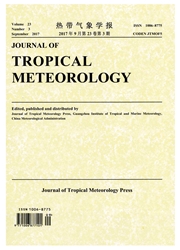

 中文摘要:
中文摘要:
Cloud resolving Weather Research and Forecasting(WRF)model simulations are used to investigate tropical cyclone(TC)genesis efficiency in an environment with a near bottom vortex(EBV)and an environment with a mid-level vortex(EMV).Sensitivity experiments show that the genesis timing depends greatly on initial vorticity vertical profiles.The larger the initial column integrated absolute vorticity,the greater the genesis efficiency is.Given the same column integrated absolute vorticity,a bottom vortex has higher genesis efficiency than a mid-level vortex.A common feature among these experiments is the formation of a mid-level vorticity maximum prior to TC genesis irrespective where the initial vorticity maximum locates.Both the EMV and EBV scenarios share the following development characteristics:1)a transition from non-organized cumulus-scale(~5 km)convective cells into an organized meso-vortex-scale(~50 to 100 km)system through upscale cascade processes,2)the establishment of a nearly saturated air column prior to a rapid drop of the central minimum pressure,and 3)a multiple convective-stratiform phase transition.A genesis efficiency index(GEI)is formulated that includes the following factors:initial column integrated absolute vorticity,vorticity at top of the boundary layer and vertically integrated relative humidity.The calculated GEI reflects well the simulated genesis efficiency and thus may be used to estimate how fast a tropical disturbance develops into a TC.
 英文摘要:
英文摘要:
Cloud resolving Weather Research and Forecasting(WRF)model simulations are used to investigate tropical cyclone(TC)genesis efficiency in an environment with a near bottom vortex(EBV)and an environment with a mid-level vortex(EMV).Sensitivity experiments show that the genesis timing depends greatly on initial vorticity vertical profiles.The larger the initial column integrated absolute vorticity,the greater the genesis efficiency is.Given the same column integrated absolute vorticity,a bottom vortex has higher genesis efficiency than a mid-level vortex.A common feature among these experiments is the formation of a mid-level vorticity maximum prior to TC genesis irrespective where the initial vorticity maximum locates.Both the EMV and EBV scenarios share the following development characteristics:1)a transition from non-organized cumulus-scale(~5 km)convective cells into an organized meso-vortex-scale(~50 to 100 km)system through upscale cascade processes,2)the establishment of a nearly saturated air column prior to a rapid drop of the central minimum pressure,and 3)a multiple convective-stratiform phase transition.A genesis efficiency index(GEI)is formulated that includes the following factors:initial column integrated absolute vorticity,vorticity at top of the boundary layer and vertically integrated relative humidity.The calculated GEI reflects well the simulated genesis efficiency and thus may be used to estimate how fast a tropical disturbance develops into a TC.
 同期刊论文项目
同期刊论文项目
 同项目期刊论文
同项目期刊论文
 期刊信息
期刊信息
